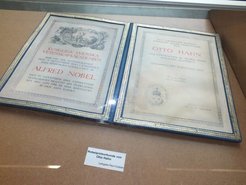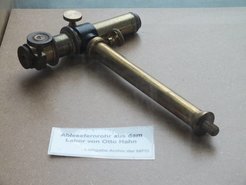The Discovery of Nuclear Fission
Station 2

Nuclear fission was discovered at the Kaiser Wilhelm Institute for Chemistry in December 1938. While bombarding uranium with neutrons, Otto Hahn and his colleague Fritz Straßmann discovered that fission products such as barium were also created in the process. In January 1939, Lise Meitner and her nephew Otto Frisch provided the explanation. As an Austrian Jew, Meitner had emigrated from Germany in the summer of 1938, but she continued to correspond with Hahn from her exile in Sweden.
Experiments by Enrico Fermi, notably the irradiation of uranium with neutrons in 1934, set the stage. Over the course of many years of work, Hahn, Meitner and Straßmann tried to explain the processes they observed. They hypothesized that elements heavier than uranium – transuranium elements – were formed during bombardment. On 19 December 1938, they arrived at an unexpected conclusion: Hahn and Straßmann showed, with the help of special chemical separation and analytical methods, that the reaction products observed were radioactive barium isotopes. Evidently, during the experiments the atomic nuclei ‘burst’, as Hahn so famously put it. This was something the chemists were unable to explain theoretically – all the more so given that this ‘bursting’ was at odds with all previous experience.
Meitner and Frisch realized that the uranium nucleus can be pictured as an electrically charged drop of liquid in accordance with the previously formulated drop model. Capturing an extra neutron caused the nucleus to oscillate so much that it split into two fragments of roughly equal size and releasing a huge amount of energy in the process. Frisch called the previously unknown nuclear reaction ‘nuclear fission’, which quickly caught on internationally
Notes on nuclear fission - the second Nobel Prize
Exhibit 2: Otto Hahn's diary

The chemist Otto Hahn, a student of Ernst Rutherford, had come to Berlin in 1906 and found a position at the university institute of Emil Fischer. Fischer also arranged for him to become head of the Radioactivity Department at the newly established Kaiser Wilhelm Institute for Chemistry. In 1919, a division took place: the Radiophysics Sub-department was now headed by Lise Meitner, while Otto Hahn ran the Radiochemistry Sub-department – they continued to be referred to as the Hahn/Meitner Department.
In 1928, Hahn was appointed director of the Institute, a position he held until 1946.
He documented his work and private appointments in notebooks. On the day of the discovery of nuclear fission, December 19, 1938, he recorded the following words:
19 Montag
Bosch wegen Wohnung!
La-Ac-Fraktionen!
Hörlein

He was probably referring to Carl Bosch, then president of the KWS, and Heinrich Hörlein, then treasurer of the Institute.
Hahn and Straßmann were well aware of the chemical significance of their findings, as they submitted their results for publication on December 22. They were published in the journal “Die Naturwissenschaften” on January 6, 1939. Meitner and Frisch provided the physical explanation in a manuscript to “Nature” in mid-January 1939, which was published on February 11, 1939.
The publications prompted an extraordinary response from the scientific community, as nuclear fission opened up a new source of energy on a scale previously unknown – nuclear energy.




